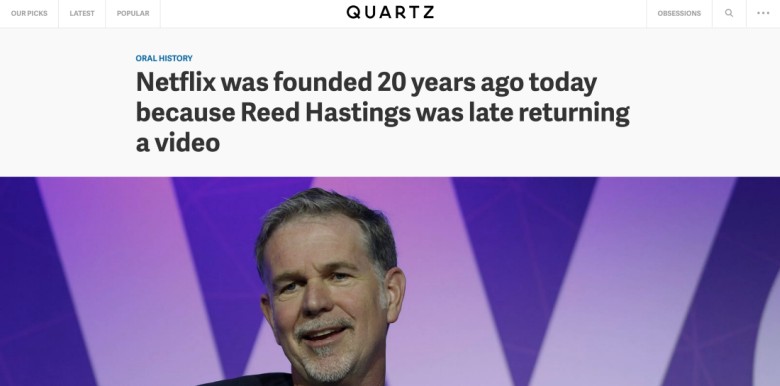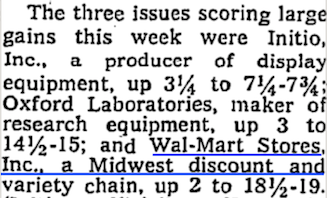Why should ignore the history of the founders of successful startups
Foundation stories are myths
Foundation histories almost always lie unintentionally. Take Netflix:

“Netflix was founded on this day 20 years ago, because Reed Hastings did not have time to return the videotape”
What really lies
Reed Hastings said many times that he had an idea for Netflix when he had to pay a $ 40 fine for being late with renting a videotape from Apollo 13.
')
In fact, this is fiction .
This is unfortunate, because such fabrications inevitably mislead anyone who thinks about how to set up their company [see also a Hyndsite error - footnote. trans.].
Sam Walton's success

The sign of the first store Walmart
Sam was already 44 (!) Years old when he opened the first Walmart store. And by that time, he managed his own retail chain for over 15 years.
He wondered why people are so focused on building a Walmart network:
Somehow, over the years, people had the impression that a middle-aged man just picked up and invented Walmart from nothing, that it was just a great idea that instantly became successful ...
But like most instant success stories, the process took about 20 years.
If you are trying to create your own business and want to learn from the "founder of Walmart", then it is silly to look at the launch of this project, because at that moment Walton already had 15 years of experience.
Let's start with his first store.
Sam's biggest mistake in professional life
Sam Walton began his career in retail, having bought his first department store under the Ben Franklin franchise at the age of 27.
As a newbie, he relied on a proven franchise scheme, but also introduced his own experimental innovations.
Like this:
- Put popcorn and ice cream machines in front of the store to attract visitors.
- Provide huge discounts, and in bulk (that is, no joke).
- Buy goods directly from manufacturers, and not through the franchise (which allowed to reduce prices).
He worked hard with this single store for five years, increased sales 3.5 times to $ 250,000 a year and became the best franchisee Ben Franklin in his region of six states.
But then I realized that I had made a huge mistake.
When he signed the lease for the building for the store, he did not include a clause on the extension of the contract.
The owner of the building (local rival store) saw his success and refused to renew the lease at any price, thereby forcing Sam to close the store.
Imagine that you are working on something for five years in a row, become the best in your business, and then one person put an end to everything.
Sam was devastated:
It was the bottom of my business career. My stomach was twitching. I could not believe that this was happening to me ... I created the best department store in the whole region and worked hard with the population - I did everything right - and they drove me out of the city. It seemed unfair. I blamed myself for agreeing to such terrible lease terms, and was furious with the owner.
He was angry, but accepted the challenge:
I always took problems as challenges, and it was no different ... It was necessary to get together and fix everything, repeat everything again, but this time even better.
If Facebook or Google change their algorithms, then at least they will have an old customer base and business assets.
But with the new retail store, you have nothing.
And because of the structure of the city, you can’t just open another store somewhere nearby.
The Waltons literally had to collect things - and the family of six people was looking for a new city.

If Sam Walton wanted to have a good time, then he had many reasons for this: he started all over again in a smaller city (Bentonville) and in conditions of certain competition (three other department stores).
But Sam said: "It was unimportant, because I had big plans."
Nonexistent determination
The next 12 years have passed without any significant events .
This is the most important part of every “instant success” that is not told in the Success Stories books.
No one here writes about all the occasional blunders and mistakes you make.
- For example, that Sam Walton tried to open a mall 10 years earlier and lost $ 25,000?
- Or how the tornado destroyed his best store? All that he could say: "We just restored it and returned to work."
It is important to know if you are trying to learn from Walton. But such facts do not fit into any story.
The lesson is that on any path to success there will be mistakes and problems. As stated in a recent book by Ryan Holiday, these obstacles are the path itself .
A colleague said that Sam succeeded in this regard, because every day he woke up "with the decision to improve something," and that he
less afraid of being wrong than everyone I've ever known ... As soon as he sees that he was wrong, he just shakes off and goes the other way.
You won't see anything like that in Reed Hastings when he talks about $ 40. You think, “I understand, I need a great idea,” when in fact an idea is nothing, and your psychology and perseverance is everything.
In the end, Walton expanded to 15 stores and by 1960 became the largest independent department store operator in the United States, receiving a total of about $ 12 million in annual revenue (in 2018 dollars).
Would you have invested in Sam Walton?
Only at this stage, Walton finally saw the opportunity to open much larger discounters and began working on the first Walmart.
He was the most successful independent operator in the United States and had 15 years of experience in retail - surely it was easy for him to attract investors' money?
That's not it.
Sam turned to the owners of other stores, entrepreneurs, competitors ... basically, all refused.
He found a measly 5% of the required amount from his brother and the store manager - and had to take another 95% (having laid his house and all the other stores).
Even the great Sam Walton could not find investors to launch the first Walmart, having a near-perfect retail business history.
First wal-mart
Finally, there comes a stage at which most people turn their attention in search of experience, and this is the end of our story.
The first Walmart is an ugly retail store (2.4-meter ceilings, concrete floor, wooden fittings), but it was successful because Walmart prices have always been better than competitors.
(Even the name “Walmart” was chosen considering the economy: it was cheaper to buy neon signs for 7 letters than the longer names Walton considered).
And you think he was worried about what the press thinks about its stores?
The New York Times does not mention Walton or Walmart until 1969, seven years after the opening of the first store, and this is just one random quote from the back of the paper:

Sam Walton's first mention in the New York Times
And the 1970 IPO was only once mentioned on page 44 of the NY Times:

Page 44 of NYT mentions Walmart IPO a week after the event.
If you want to learn from entrepreneurs, look at the start, not at the finish.
Source: https://habr.com/ru/post/351052/
All Articles